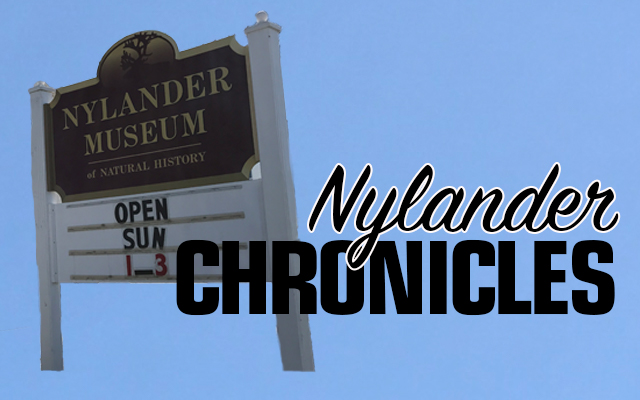There is a new display in the Nylander Museum of Natural History that is different from all the rest. It’s full of Native American artifacts, many local, some from far away, and tells the unique history of how indigenous people made use of the environment around them to survive. Some were collected by Olof Nylander, some were donated over the years from other collectors and archaeological projects.
The most noticeable part of the collection is a group of 52 biface (meaning flintknapped on both sides) blanks from Baker Lake, found as a cache. These tool pre-forms are made from rhyolite collected from Mount Kineo. Mount Kineo is essentially a cliff of rhyolite, an igneous formation, that rises on a peninsula over Moosehead Lake. Native Americans traveled to Mount Kineo for about 11,000 years to collect the geographic feature’s rhyolite rock. Rhyolite is similar in properties to flint, and is often called “Kineo Flint.”
Numerous tribes traveled long distances, sometimes even hundreds of miles, to obtain Kineo rhyolite. The material was traded to groups farther afield, as lithic tools made from this stone have been found throughout New England and the Maritimes. Many of the stone tools found in the Moosehead Lake region are trade blanks, meant to be carried long distances and traded with other groups that would further refine the piece.
Another material used for stone tools in Maine is chert, which is a fine-grained sedimentary rock made up of silica. There are a variety of types of chert; however, there are several beautiful red chert artifacts in the Nylander Museum collection. This very recognizable and unique red chert is from the Munsungun Lake region, and is well known in archaeological sites throughout New England, the Maritimes, and even Quebec.
Red Munsungun Chert was likely a precious resource for Paleoindians in Maine, as it is often found on archaeological sites in the form of fluted points. Fluted points were some of the earliest stone tools seen in North America, often associated with the Clovis culture, which is a prehistoric culture thought to be the ancestors of modern indigenous tribes. Fluting, or creating a groove down each side at the base of the point, likely allowed for shock absorption when hunting. Outcrops of chert in the Munsungun region were heavily utilized by the earliest peoples in Maine, and were clearly a valuable natural resource for hunting.
Lastly, the Nylander Museum has on its property a Native American medicinal garden surrounded by a wall of large rocks, which was created in 1985. This garden includes 80 species of plants native to Maine and used by indigenous peoples for medicinal purposes. Some of the plants included are Black-Eyed Susans, which were used for indigestion, wormwood, used for strained muscles, and yarrow, used to induce sweating and reduce fever. While many of the plants in the garden are naturally poisonous, they all served a specific use to the indigenous peoples of Maine, who collected and protected them as a natural resource.
The natural resources of Maine are plenty, including plants, trees, rocks and minerals. Naturalists like Olof Nylander understood the importance of such resources, and he was very interested in indigenous artifacts and plants in the area. He also understood the need to record these resources, as well as protect them in the future by educating the public.
Here at the Nylander Museum, we hope to continue his legacy of recognizing the Native American tribes of Maine and their contribution to Maine history, as well as the wonderful natural resources that aided in their survival in this beautiful region.
Jada Molton is a VISTA volunteer serving the Nylander Museum this summer.








